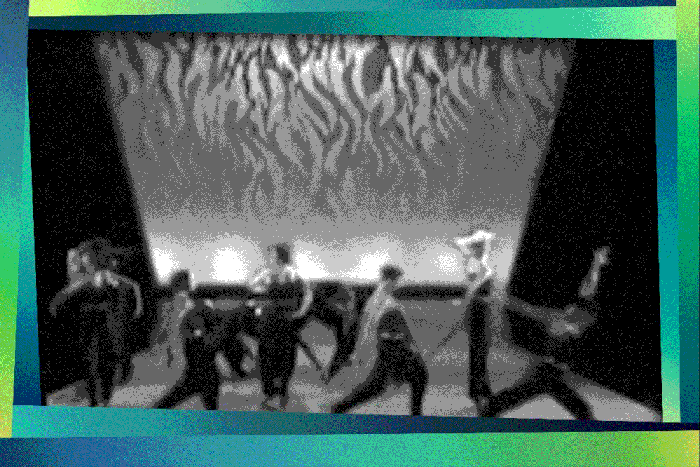
For the 70th Oscars ceremony in 1998, producer Gil Cates had an idea: Why not gather 70 Oscar-winning actors and actresses on the stage at once? He unveiled all of them seated, arranged alphabetically from Anne Bancroft to Teresa Wright, and an announcer read each of their names to the audience along with the films for which they won trophies. This “Oscars Family Album” gambit took nearly 15 luxurious minutes, live on TV, while the stars whispered and nudged one another. Rita Moreno seemed delighted by Frances McDormand. Holly Hunter and Anjelica Huston looked to be having a full-on conversation at one point. And one can only guess at the memories a teenage Anna Paquin has of being wedged between Jack Nicholson and Estelle Parsons.
My first thought after watching all this was, Wow, I wonder what Cher and Julie Christie talked about. The second? We won’t ever see anything like this again on an Oscars telecast.
And we won’t. At least not while the ceremony remains on ABC, which seems determined to chase away viewers who don’t watch the Oscars at the expense of ones who do. This year, the pursuit has yielded crass appeals to popular taste such as the Fan Favorite award and the Oscars Cheer Moment as well as the decision to cut the number of televised categories in the hopes of shortening the ceremony. The Oscars should not be shortened, of course. The Oscars should be long, as a smart person once said here, and moments like the Oscars Family Album are exactly why. For one night a year, Hollywood should remind us why we love it: for its extravagance, its talent, and its self-indulgence.
The Oscars once favored flashy, time-consuming, glorious stunts that would turn ABC executives to stone if suggested for today’s telecast. But in the name of pageantry and, if for no other reason, the memes you can imagine would result from each, here are five of the kinds of mini-productions we think the Oscars should be pulling off instead of slimming down.
The Oscars Family Album
The 70 Oscar winners were still noisily taking their places behind the stage apparatus as Susan Sarandon announced to the audience that the gathered actors would be winners of lead, supporting, and juvenile Oscars as well as honorary Oscar winners. Once Sarandon, a Dead Man Walking Best Actress winner herself, had scurried to her seat between Eva Marie Saint and Maximilian Schell, there were no speeches, no clip packages, no flashbacks to speeches past. Just a recitation of names and the wonder and awe that came with seeing the likes of Gregory Peck, Sidney Poitier, Shirley Temple, Jack Lemmon, Jennifer Jones, and dozens more in the same place. As the camera moved down the line, the audience was free to marvel, to reminisce, and to imagine just what these alphabetically adjacent movie stars were chatting about.
The lineup did not include every living Oscar-winning actor, as it’s sometimes misremembered, and it’s hard not to miss some of the absentees (whither Al Pacino, Barbra Streisand, Shirley MacLaine, Tom Hanks, Meryl Streep?). But the Family Album recalled one truth about the Oscars that’s often forgotten in the scramble to lure younger viewers and blockbuster nominees: The Oscars are a scrapbook of the year in movies, yes, but they’re also a tether to a shared history and a continuum that keeps growing and expanding.
It’s also worth noting, in case you fear that taking 15 minutes to pan a camera past Red Buttons and Shelley Winters might have been ratings poison, that the 70th Academy Awards remain the highest-rated Oscars in history.
The five-person presenter teams for the actors
Whatever got into 81st Academy Awards producers Bill Condon and Laurence Marks, please bring it back. Hugh Jackman made for a delightfully game host, and Roger Ebert called it the best Oscars he’d ever seen. By far the most indulgent choice was reserved for the acting categories. The tradition is for the previous year’s acting winners to present the current nominees in each category, but Condon and Marks had five previous winners in each category emerge like the gods from Olympus and deliver a personalized tribute to each nominee. As with the Oscars Family Album, this was another way to connect the Oscars’ past with its present. If you’re the kind of fan who gets a thrill out of actresses addressing one another, get ready, because Sophia Loren addresses the shit out of Meryl Streep. Goldie Hawn is so sweetly complimentary to Taraji P. Henson. Does Anthony Hopkins subtly call upon the memory of Meet Joe Black when addressing Brad Pitt? He sure does.
The next day, the usual snipers complained that the presentations were overlong and self-indulgent, which, as previously discussed, are nonstarters when it comes to dissing anything about the Oscars. The next year, they switched it up, reserving the five-wide presenters for only the lead-acting categories and opening it up beyond previous Oscar winners to include anyone with a personal or professional bond with the nominee. That turned out to be fun, too — nothing that allows Stanley Tucci to tease Streep can be anything less than delightful. But after this two-year experiment, it was back to single-presenter categories, and it’s incredibly hard to imagine the current regime would allow such leisurely presentations to return.
The supermodel fashion show for Best Costume Design
Once upon a time, rather than punt the less starry Oscar categories to a preshow anteroom, the Oscars used to try to snazz the craft categories up. Give ’em a little razzle-dazzle. One of the more famous/infamous of these occasions was the Best Costume Design presentation at the 68th Academy Awards. Producers David Salzman and Quincy Jones decided to preface the costume award with a runway fashion show in which supermodels strutted in costumes from the five nominated films. Pierce Brosnan, our then-newly minted James Bond, arrived flanked by Claudia Schiffer and Naomi Campbell to introduce the mini-event staged by photographer Matthew Rolston. Tyra Banks and Patricia Velásquez stomped the runway in Jenny Beavan and John Bright’s looks from Sense and Sensibility. Marcus Schenkenberg and Frederique van der Wal struck poses in Shuna Harwood’s costumes from Richard III. Tyson Beckford looked for all the world like a vacuum-packed sous-vide in a postapocalyptic hazard suit from 12 Monkeys.
As a time capsule, the moment is divine. It captures the very instant supermodel culture reached its mainstream apex. As a spectacle, it was decades before its time, a moment practically begging for a million Twitter memes to spring forth in an instant. The Oscars would never dare to seem this cringey again, which is also why they’ll never be this cool.
Modern-dance numbers for Best Original Score
As with the Best Costume Design fashion show, the Oscars often try to dress up the Best Original Score category. While its glitzier cousin, Best Original Song, regularly gets full-length performances from the likes of Beyoncé and Bono, Best Original Score presents more of a challenge. Sometimes excerpts from the nominated scores are played by a famous classical musician (Itzhak Perlman, Yo-Yo Ma) over clips from the movies. These days, you’re lucky to get even a snippet while the nominees are read. (And indeed, Original Score was one of the eight banished categories this year.) But on a few occasions, the Oscars have turned to frequent collaborator Debbie Allen to choreograph modern-dance routines to dramatize the nominated scores.
And so at the 1992 Oscars, sleekly costumed dancers high-kicked and hip-swiveled to the paranoid urgency of John Williams’s JFK score, while James Newton Howard’s languid music from The Prince of Tides was commemorated by a dozen or so puffy-shirted contemporary dancers floating across the stage.
Allen was back choreographing at the 1999 Oscars, which included a flamenco routine to the Life Is Beautiful score, Savion Glover tapping to the Saving Private Ryan score, and the stunning Desmond Richardson interpreting Hans Zimmer’s indelible score to The Thin Red Line.
These moments tended to get ripped apart in the morning-after reviews, and before long, both Allen and the phrase “interpretive dance” became synonymous with the kinds of Oscars excess that pushed the show past midnight in the Eastern time zone. By the mid-aughts, they were largely phased out in favor of … well, nothing.
Best Original Song extravaganzas
Speaking of Allen, no one person better personifies what the Oscars used to allow and what they never would today: big, extended dance numbers and over-the-top song performances carried out with a complete lack of shame or concern that the audience might turn away. At the 1985 Oscars, Allen was tasked with performing the nominated original song “Footloose” in lieu of Kenny Loggins. This is something the Oscars have done through the years, subbing starrier names like Beyoncé or Antonio Banderas in place of the original artists. Whether that’s right or wrong is a conversation for another day because, with all due respect to the man who wrote and recorded “Playing With the Boys,” Loggins could never have delivered what Allen did on that stage.
For five entire minutes, Allen never once stops moving, high-stepping and shimmying across every inch of an enormous set styled, for some unfathomable reason, like the jagged remains of a glitter-clad asteroid that crashed into the planet Xanadu. There are leg warmers; there are keytars; at one point, Allen extends her leg and rests it upon the raised leg of a prone dancer. She put on a show. And when it was all over, the camera cut to Loggins in the 84th row of the Dorothy Chandler Pavilion, and he was all smiles.
This was the same Oscars that featured Ann Reinking’s disastrous rendition of Phil Collins’s “Against All Odds,” so not all the Best Original Song performances turned out quite so well, but don’t you want an Academy Awards that tries this hard to entertain you rather than one that races against the clock to have you in bed by a reasonable hour like some terrifyingly efficient nanny? Don’t you want Debbie Allen and Tyson Beckford and Goldie Hawn and the Alvin Ailey Dance Company? Don’t you want the Oscars back?


